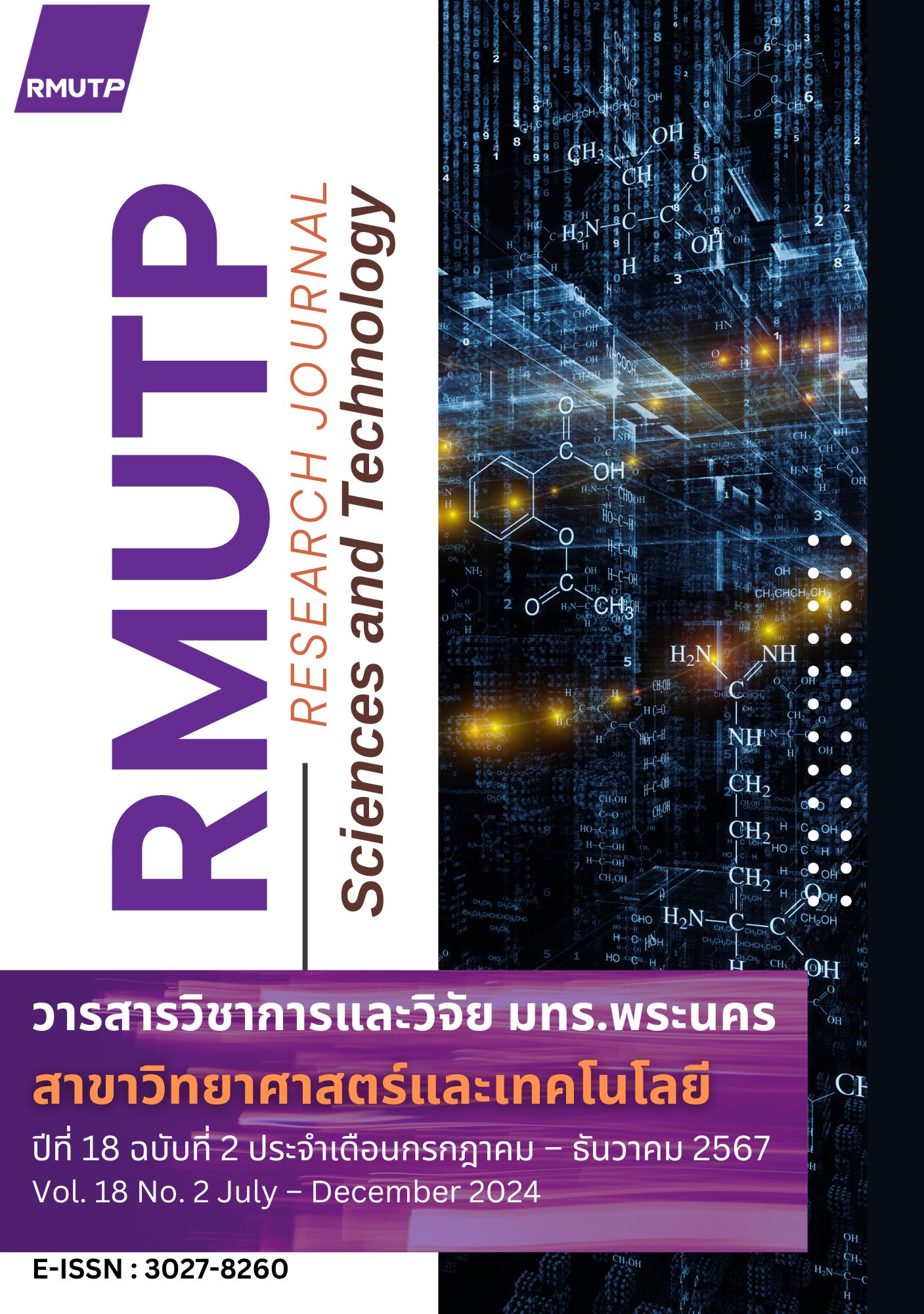Temperature and Relative Humidity Control in a Greenhouse Evaporative Cooling-pad system
Main Article Content
Abstract
This research aimed to study the control of temperature and relative humidity of the air inside a greenhouse equipped with an evaporative cooling pad system. The control system was divided into 3 systems: The temperature control system at 25°C, the relative humidity control system at 70% RH, and the vapor pressure deficit (VPD) control system at 0.85 kPa. It was found that on a cool day, the temperature control system can maintain an average temperature of about 25°C. However, on a hot day, the system cannot effectively control or reduce the average temperature inside the greenhouse to the required value. Nonetheless, it can successfully control the average temperature inside the greenhouse to be about 5-7°C lower than outside the greenhouse. The relative humidity control system maintained the average relative humidity inside the greenhouse at about 70% RH every day of the test, but the average temperature inside the greenhouse was about 28-35°C. The VPD control system can be maintained at the specified value for some time; it varies according to the temperature and relative humidity of the air. However, the average temperature and relative humidity inside the greenhouse were still within the suitable range for growing plants in the greenhouse. The water and electricity consumption of the system depends mainly on the weather conditions and the operation of the control system. The relative humidity control system consumes the lowest electrical consumption, while the temperature control system has the highest electrical consumption, Therefore, the temperature control system has the highest cost compared with the relative humidity control system and the vapor pressure deficit control system.
Article Details

This work is licensed under a Creative Commons Attribution-NonCommercial-NoDerivatives 4.0 International License.
ลิขสิทธ์ ของมหาวิทยาลัยเทคโนโลยีราชมงคลพระนครReferences
T. Thongket, Growing plants in greenhouses, Bangkok: Kasetsart University, 2007.
M. Soussi, M. T. Chaibi, M. Buchholz, and Z. Saghrouni, “Comprehensive Review on Climate Control and Cooling Systems in Greenhouses under Hot and Arid Conditions,” Agronomy, vol. 12, no. 626, 2022.
C. Saowarat, “AUTOMATIC CLIMATE CONTROL IN GREENHOUSE BY FOGGING SYSTEM,” M.Eng. thesis, Program in Mechanical and Process System, Suranaree Univ. of Technology, Nakhon Ratchasima, Thailand, 2017.
K. Simek, “REDUCTION OF HEAT FROM SOLAR ENERGY FOR MISTING GREENHOUSE,” M.Eng. thesis, Program in Mechanical and Process System Engineering, Suranaree Univ. of Technology, Nakhon Ratchasima, Thailand, 2019.
I. Tsafaras, J. B. Campen, C. Stanghellini, H. F. de Zwart, W. Voogt, K. Scheffers, A. Harbi and K. Assaf, “Intelligent greenhouse design decreases water use for evaporative cooling in arid regions,” Agricultural Water Management, vol. 250, 2021.
W. Baudoin, R. Nono-Womdim, N. Lutaladio, and A. Hodder, Good Agricultural Practices for greenhouse vegetable crops, Rome: Food and Agriculture Organization of the United Nations, 2013.
S. Ghani, F. Bakochristou, E. M. Elbialy, S. M. Gamaledin, M. M. Rashwan, A. M. Abdelhalim and S. M. Ismail, “Design challenges of agricultural greenhouses in hot and arid environments – A review,” Engineering in Agriculture, Environment and Food, vol. 12, no. 1, pp. 48-70, Jan. 2019.
I. Norkaew, “Energy Saving in Climatic Controlled Greenhouse with Evaporative cooling Using Excess Cool Water from Ice Factory,” M.Eng. thesis, Graduate School, Chiang Mai Univ, Chiang Mai, Thailand, 2000.
A. Arble, O. Yekutieli, and M. Barak, “Performance of a Fog System for Cooling Greenhouses,” Journal of Agricultural Engineering Research, vol. 72, no. 2, pp. 129-136, 1999.
C. Kittas, T. Bartzanas, and A. Jaffrin, “Temperature Gradients in a Partially Shaded Large Greenhouse equipped with Evaporative Cooling Pads,” Biosystems Engineering, vol. 85, no. 1, pp. 87-94, 2003.
J. Xu, Y. Li, R. Z. Wang, W. Liu, and P. Zhou, “Experimental performance of evaporative cooling pad systems in greenhouses in humid subtropical climates,” Applied Energy, vol. 138, pp. 291-301, Jan. 2015.
M. Sultan, T. Miyazaki, B. B. Saha, and S. Koyama, “Steady-state investigation of water vapor adsorption for thermally driven adsorption based greenhouse air-conditioning system,” Renewable Energy, vol. 86, pp. 785-795, Feb. 2016.
M. Amani, S. Foroushani, M. Sultan, and M. Bahrami, “Comprehensive review on dehumidification strategies for agricultural greenhouse applications,” Applied Thermal Engineering, vol. 181, Nov. 2020.
F. W. Murray, “On the computation of saturation vapor pressure,” Journal of Applied Meteorology, vol. 6, pp. 203-204, Feb. 1967.
ASHRAE Handbook Fundamentals, American Society of Heating, Refrigerating and Air-Conditioning Engineers, Inc., 2009.
H. Oz, A. Atilgan, K. Buyuktas, and T. Alagoz, “The efficiency of fan-pad cooling system in greenhouse and building up of internal greenhouse temperature map,” African Journal of Biotechnology, vol. 8, no.20, pp. 5436-5444, Oct. 2009.
M. Dayioglu and H. Sİllelİ, “Performance Analysis of a Greenhouse Fan-Pad Cooling System: Gradients of Horizontal Temperature and Relative Humidity,” Journal of Agricultural Sciences, vol. 21, no. 1, pp. 132-143, 2015.
I. M. A. Aljubury and H. D. Ridha, “Enhancement of evaporative cooling system in a greenhouse using geothermal energy,” Renewable Energy, vol. 111, pp. 321-331, Oct. 2017.
A. Alsadon, I. Al-Helal, A. Ibrahim, A. Abdel-Ghany, S. Al-Zaharani, and T. Ashour, “The effects of plastic greenhouse covering on cucumber (Cucumis sativus L.) growth,” Ecological Engineering, vol. 87, pp. 305-312, Feb. 2016.


